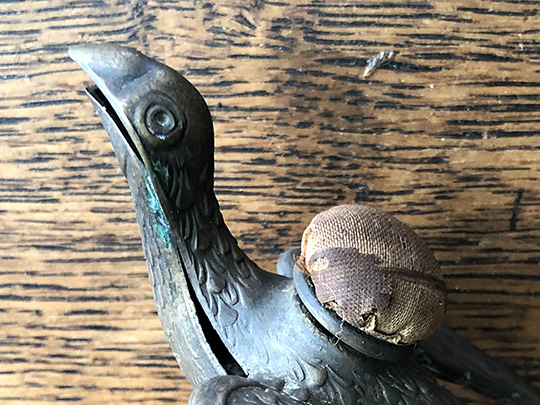Introduction and Table of Contents
|
Claudia Emerson Sewing Bird Sewing Bird [transcription, 2007 manuscript] Sewing Bird [facsimile, 2007 manuscript] Sewing Bird: A Collaboration Three Snapshots |
|
| A link to Blackbird’s “Claudia Emerson Reading Loop” menu appears at the bottom of every page of related content. You may also return to this menu at any time by visiting Features. |
Welcome to the Claudia Emerson Reading Loop, materials gathered to recognize the life, work, and mentorship of Claudia Emerson. Here, Blackbird seeks to support her legacy through her poetry and other related content.
Blackbird’s relationship with Claudia Emerson’s work began in v1n2 with a review of Pinion and continued in the following issue with poems that would subsequently appear in Late Wife, her Pulitzer winning third book. In an essay in v5n1, Susan Williams noted Emerson’s appreciation of the quotidian, particularly
of how objects often provide a way of
understanding the rural women who are
frequently her subjects.
From the beginning, Emerson has had an impeccable eye and ear for the details of farm life: words like “disremember,” phrases like “the devil’s beating his wife” (for rain falling while the sun shines), images of a grandmother’s false teeth in their jar, of graves being reclaimed by the fields into which they are sunk, of the harsh, unending demands of the farm and farmhouse.
She has always understood the resonance of objects—a dead woman’s toiletries (“snaggletooth combs, / the warbled wire of hairpins”) included by her aging widower among goods to be auctioned (“no daughters to know what must not be / sold”), “the weather vane / rust-frozen in its socket” in an abandoned house.
This issue’s Loop focuses particularly on one of those objects, a sewing bird, which Emerson describes in a poem by the same name:
No bigger than the span of any woman’s
hand, this one was cast in ornate brass,even the thumb key, designed to clamp the bird
to the table’s edge made decorative.
 |
| Claudia Emerson’s Sewing Bird (detail) Photo by Kent Ippolito |
Birds figure frequently in her work (often as representatives of the lyric song of the poet). The poem “Sewing Bird” arose from a 2007 collaboration between Emerson and her friend sculptor Carole Garmon while both were members of the faculty at Mary Washington University. In an interview with Blackbird’s M.A. Keller, Garmon describes the acquisition of their sewing birds:
Randolph-Macon Gallery Director, Katie Shaw, contacted us about her idea to pair artists and writers for a group exhibition. We both agreed and began the brainstorming of how we would approach this. We both have particulars when developing ideas so we agreed to focus on an inanimate object and move on from there.
We came upon these sewing birds in an antique store in downtown Fredericksburg and purchased them. So it’s hilarious—it speaks to our personalities—that she chose the Emily-Dickinson-kind-of-Victorian sewing bird, and I was like, “Yeah! I want that sleek kind of modernist approach.”
The curious woman at the counter asked why we would be so interested in sewing birds and we replied, “We’re gonna make some art!”
Blackbird’s presentation includes a short history of sewing birds, images of Garmon’s work from the show, a reproduction of Emerson’s first version of her poem that appeared on the exhibition wall in her handwriting, and the text of the poem as it was collected in her 2008 book Figure Studies. Garmon’s interview discusses the show and more generally how she and Emerson shared work and developed a lasting friendship.
Three snapshot photos of Emerson in the summer of 2013 at Sewanee Writers’ Conference also appear here.
Please continue to take pleasure in, and be inspired by, Claudia Emerson’s poetry and the work of countless others she influenced, taught, or mentored. ![]()
Contributor’s Notes: Claudia Emerson
Contributor’s Notes: Carole Garmon